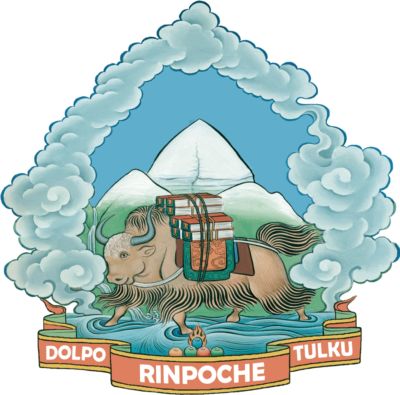The Longchen Nyingtik lineage includes both the terma of Longchen Nyingtik discovered by Jikmé Lingpa and teachings of Longchen Rabjam revealed to Jikmé Lingpa in a series of visions.
Longchen Rabjam (1308-1364), also known as Longchenpa, was one of the greatest Dzogchen masters of the Nyingma tradition and one of the most brilliant and original authors of Tibetan Buddhist literature. That is why Dolpo Tulku Rinpoche also relies mainly on Longchen Rabjam’s Precious Treasure of Philosophical Systems in his four-year Buddhist study program, the Longchen Shedra.
The practice of Dzogchen, the great perfection, is based on realizing our Buddha nature by overcoming our mental structures and concepts. Nyingtik means the heart essence and clarifies that Dzogchen embodies the quintessence of Buddha’s teachings in reason, path and result.
Realizing this great perfection beyond the conceptual mind is the goal of the Dzogchen tradition.
Rigdzin Düpa

Rigdzin Düpa (Assembly of Awareness Holders) is an inner Lama practice from the Longchen Nyingtik tradition, which is one of the most important Nyingma Dzogchen systems. The practice comes from a terma text discovered and taught by Jikme Lingpa (1730-1798).
The powerful practice of Rigdzin Düpa helps us overcome our ingrained habitual patterns to dwell in the nature of our mind. According to the Dzogchen tradition, visualization is generated instantaneously rather than gradually, so that the ordinary perceptual process of our mind is broken.
With the cessation of ordinary perception, which is clouded by thoughts and emotions, the original clarity, our pure awareness (rigpa), emerges.
If we manage to rest in this pure awareness, which is empty in its essence and emerges as clarity according to its nature, our enlightened qualities will fully emerge. Through this working out of our Buddha nature beyond the conceptual mind, our inherent all-pervading compassion is strengthened, enabling us to support all beings in the greatest possible way.
Khandro Gekyang Chöd

The Chöd practice Khandro Gekyang (Tib.) or ‘The Loud Laughter of the Dakinis’ is part of the Longchen Nyingtik cycle, a practice and teaching cycle from the Nyingma tradition revealed by Jikme Lingpa.
The word chöd means to cut or sever. What we need to cut through is our grasping for an inherent self. Self-centeredness and our clinging to an inherent self are the foundation of all our negative emotions, we can observe this in our everyday experiences.
So how does Chöd practice cut through this self-centeredness? Through the practice of love and wisdom; through the sword of love and compassion.
One’s own body and life are the most important things to all people. Chöd practice is about mentally letting go of one’s own life, that which one values most, and offering it to others. By transforming our bodies into nectar and thereby satisfying the needs of all beings (including those that cause harm), we can release and integrate the energy bound up in our attachments and fears, recognizing and pacifying them as part of us. In this way, we sever the root of our negative emotions, can let go of concepts and habitual patterns, and dwell in the nature of phenomena.
Chöd practice is considered to be very helpful in curing many diseases and protects against harm caused by demons as the embodiment of our fears.
Riwo Sangchö (Smoke Offering)

Riwo Sangchö, or literally “mountain smoke offering,” is a famous practice of sang offering revealed by the great yogi and tertön (treasure finder) Lhatsün Namkha Jikmé (1597-1653). Lhatsün Namkha Jikmé was an incarnation of both Vimalamitra and Longchenpa.
There are many different sang offering practices, however in the 1970s Dudjom Rinpoche arranged the original practice of Riwo Sangchö into a shortened version for daily practice once a week by Dolpo Tulku Rinpoche’s Sangha online.
Riwo-Sangchö embodies the view of Dzogchen (the great perfection) and in its essence belongs to transcendental bounty within the Buddhist context.
The Tibetan term “Sangchö” consists of two words, sang and chö. Sang means to purify, and in this context it is to purify the result of our actions committed through harmful states of mind, as well as the pollution of the environment that attacks our health.
Cleaning takes place on three levels:
- On the outer level to balance the five elements
- On the internal level to take care of our nerves, chakras, winds and internal fluids.
- On the secret level, to strengthen our rigpa, our pure awareness
The second word chö means to offer. We put the purifying substances into the fire and offer the smell of the smoke that is produced.
The motivation to practice the Riwo Sangchö incense offering should include the intention to tame our minds to be able to help all sentient beings in the best possible way.
